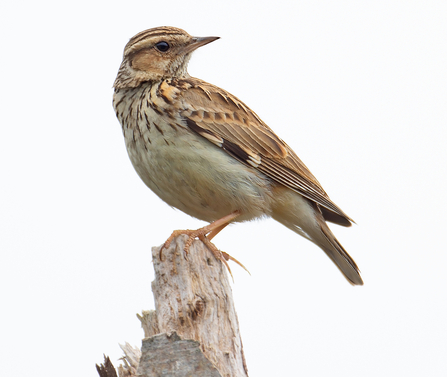
Woodlark © Jon Hawkins – Surrey Hills Photography
50% of membership for a limited time
Woodlarks © Jon Hawkins – Surrey Hills Photography

Woodlark © Jon Hawkins – Surrey Hills Photography
The Woodlark is a songbird found mainly in the heathlands and grasslands of the British countryside. It is a petite bird, with an overall length of only 15cm - slightly smaller than its relative the Skylark. Both species are a streaky brown and white and boast crests on their crowns; however, the Woodlark has a shorter tail and more rounded wings, making it identifiable to its own kind and to us!
Woodlarks are commonest in southern England. They are listed on Schedule 1 of the Wildlife & Countryside Act (1981, as amended), which lists rare bird species that are especially protected. It is an offence to intentionally harm, capture or kill a Woodlark or its eggs and young, or to even remotely disturb it whilst breeding.
The overall population of Woodlarks both in the UK and internationally is steadily recovering, according to IUCN Red Lists, where Woodlarks are categorised as of ‘least concern’ of extinction. Sadly however, Skylark numbers are declining across Europe, with rapid declines noted in the UK.
Woodlarks tend not to migrate internationally, making them ‘resident’ birds; however, they do seek out milder areas within their territories during the winter months. Woodlarks found in the east of their range do occasionally migrate further south at the start of winter to avoid bitter winter months, as the weather may limit available food supplies. Generally, the Woodlark eats seeds and insects throughout the year.
Woodlarks are known for being one of few birds that sing in the dark and can be heard doing so from the early weeks of February. Both the male and female Woodlark sing and respond to different messages relayed to each other using different pitches and sounds. As with the Skylark, the male Woodlark has a flight song. However, a tell-tale distinction between these two species is clearly apparent when the birds are in the air, as Woodlarks often spiral when in flight and maintain a comparably lower altitude.
Woodlarks often start singing earlier in the year than other birds, and their song in early February is a first sign of spring. The early schedule of these busy birds means that their first egg is often laid by the end of March.
The mother Woodlark incubates her eggs (usually three to five) for up to fifteen days. Once the speckled eggs have hatched, families stay together throughout the summer to ensure that the developing fledglings are ready to move on from their parents in the autumn.
Skylarks and Woodlarks tend to favour slightly different respective locations. If you were to find a lark singing on farmlands and exposed grasslands, it is most likely to be a Skylark. Woodlarks on the other hand tend to be located in heathlands and open woodlands when in flight.
Maintaining heathlands, grasslands and woodlands is nonetheless vital for the future of both these species, given the pace at which these areas are being lost to agriculture and development. By managing land sustainably for nature and encouraging other landowners to do likewise, Surrey Wildlife Trust is determined to ensure that more viable habitats are created and sustained long into the future.